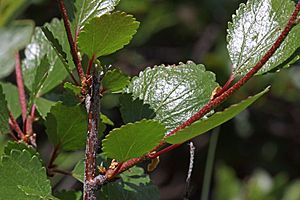American dwarf birch facts for kids
Quick facts for kids American dwarf birch |
|
|---|---|
 |
|
| Scientific classification | |
| Genus: |
Betula
|
| Species: |
glandulosa
|
The American dwarf birch (scientific name: Betula glandulosa) is a type of birch tree. It's also called resin birch or shrub birch. You can find it growing naturally in North America.
What it Looks Like
The American dwarf birch is a shrub that has many stems. It usually grows about 1 to 3 meters (3 to 10 feet) tall. Often, it forms thick, dense groups of plants.
Its stems are thin, usually not more than 5 to 10 centimeters (2 to 4 inches) wide. The bark on these stems is smooth and dark brown.
The leaves are almost round or oval in shape. They are about 0.5 to 3 centimeters (0.2 to 1.2 inches) long. They also have edges that look like tiny teeth.
The plant produces catkins, which are like small, hanging flower clusters. These catkins stand upright and are about 1 to 2.5 centimeters (0.4 to 1 inch) long. They are also about 5 to 12 millimeters (0.2 to 0.5 inches) wide.
This birch is very similar to the dwarf birch (Betula nana). Sometimes, scientists even consider it a type of dwarf birch. You can tell them apart because the American dwarf birch has tiny bumps called glandular warts on its new shoots. Its leaf stems are also longer. This plant can also create hybrids by mixing with other types of birches.
Where it Grows
This plant lives in arctic and cool temperate areas. You can find it from Alaska in the west all the way to Newfoundland and southern Greenland in the east.
It also grows south in high mountains. These areas include northern California, Colorado, and the Black Hills of South Dakota. In the eastern part of its range, it grows as far south as northern New York.
In very cold Arctic regions, it can grow near sea level. But in the southern parts of its range, it prefers high places. It can be found as high as 3,400 meters (11,150 feet) above sea level.
The American dwarf birch often grows in wetlands. These include wet, spongy areas like bogs and muskegs. It likes soils that are moist and don't have many nutrients. However, it can also grow in many other places. These range from rocky subarctic areas to thick boreal forests with rich soil.
In Alaska, it is the most common shrub found at the treeline. This is the edge where trees stop growing and open, treeless land begins. It forms a continuous zone between the treeline and the open alpine tundra.
How it Helps Wildlife
Many wild animals use the American dwarf birch as a food source. Large animals with hooves, called ungulates, eat it. These include moose, deer, caribou, and elk.
How much they eat it depends on where they live. For example, moose in Alberta, Canada, eat a lot of it. But moose in Alaska don't eat as much.
Bears, small mammals, birds, and insects also rely on this shrub for food. It provides a safe place for ptarmigans, which are a type of bird. Grizzly bears also use it to build their dens.
This plant is also good for stopping soil from washing away. It has been used to help keep stream-banks strong and stable.
See also
 In Spanish: Betula glandulosa para niños
In Spanish: Betula glandulosa para niños


